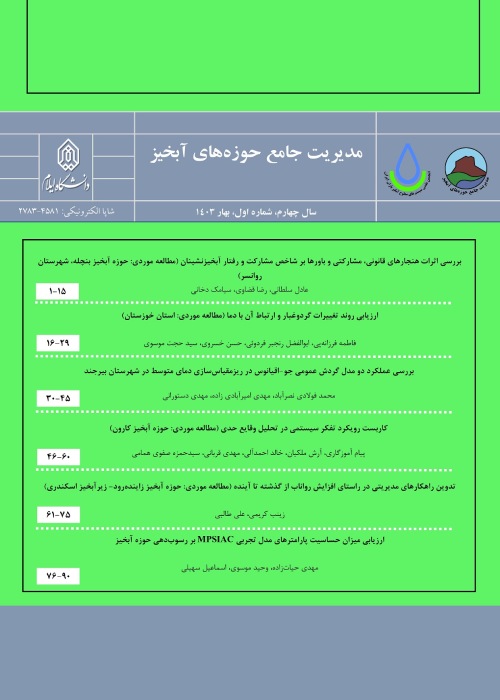Development of Management Solutions to Increase Runoff from the Past to the Future (Case Study: Zayandeh Rooud Watershed, Eskandari sub-watershed)
Eskandari sub-watershed is one of the most important water supply sources for agriculture, drinking and industry in Isfahan region and province. Therefore, better understanding of the problems within this watershed is crucial for planning and proper management. Moreover, a concerted effort to engage all stakeholders in the integrated management of this watershed is necessary. This research aims to investigate the reasons for the increase of runoff in the years 2011, 2021, and 2031, providing management solutions with the active participation of stakeholders.
First, the height of the runoff was estimated using the curve number method. In this regard, Landsat 5 and 8 satellite images from 2011 and 2021 were used to prepare a land-use map of the Eskandari sub-watershed. Additionally, the prediction of land-use changes in the future (2031) was done using the Markov model. To prepare the curve number map, the combination of the land-use map and hydrological groups was used, and then the runoff height was estimated in the studied years. Following this, through collaborative workshops, stakeholders were asked to create a problems and objectives tree based on the main reasons for the runoff progress in the watershed, consulting with each other. Subsequently, based on the objective tree, the initial list of proposed solutions for the Eskandari sub-watershed was presented. The proposed solutions were then refined, classified, and prioritized by experts. Continuing with the goals of the current research, the most important indicators affecting the current situation of the Eskandari sub-watershed were selected based on the opinions of experts and stakeholders. To model, the multi-criteria decision-making method was used to select solutions and prioritize them. Therefore, initially, the researcher's questionnaire was distributed among stakeholders for scoring the selected solutions according to the assessment criteria. Finally, the results obtained from experts' scoring were prioritized using the TOPSIS method.
The results reveal a significant reduction in natural lands in the region. Consequently, by 2031, rangelands with good and mediocre cover have been completely destroyed, while those with poor cover, irrigation, and rainfed agriculture dominate the region. Based on soil science information, 57.18% of the area is related to hydrological group B with a medium runoff production capacity. Hydrological groups C and D, with percentages of 24.98 and 17.82, respectively, are the next priorities. Following this, by combining the hydrological group map of the watershed with the land-use map in GIS environment, the CN map with curve numbers ranging from 61 to 96 was obtained. Finally, the average infiltration in 2011, 2021, and 2031 was 79.15, 62.82, and 55.12 mm, respectively, while the average runoff in those years was 10.99, 13.15, and 13.38 mm, respectively. According to the results, the losses decrease over time, while the runoff increases. Residential lands and rocky outcrops have the highest amount of runoff production, i.e. 34.38 mm, whereas rangeland with good cover (0.33) has the lowest amount of runoff. In subsequent collaborative workshops, based on the opinions and consensus of stakeholders and experts, improper agriculture was identified as one of the main reasons for increase of runoff in the studied area. Due to a lack of water, insufficient income, and a lack of laws and supervision in the region, watershed farmers and residents are changing land use and cultivating low-yielding lands in an unprincipled manner. Also, in line with the research goals, 11 management solutions and 12 effective indicators (economic, social, and environmental sectors) were identified for the current situation of the watershed. The prioritization results based on the TOPSIS method showed that the solution of creating cover farming to increase surface coverage has been assigned the highest priority.
In this research, efforts have been made to address and mitigate the runoff in the study area. Management solutions have been presented based on the preferences and participation of stakeholders. Therefore, to prevent further runoff in the region, it is suggested to establish institutions tailored to the watershed's situation, considering patterns of cultivation and conservation agriculture, and integrating the cooperation of subordinate institutions and organizations.
- حق عضویت دریافتی صرف حمایت از نشریات عضو و نگهداری، تکمیل و توسعه مگیران میشود.
- پرداخت حق اشتراک و دانلود مقالات اجازه بازنشر آن در سایر رسانههای چاپی و دیجیتال را به کاربر نمیدهد.




